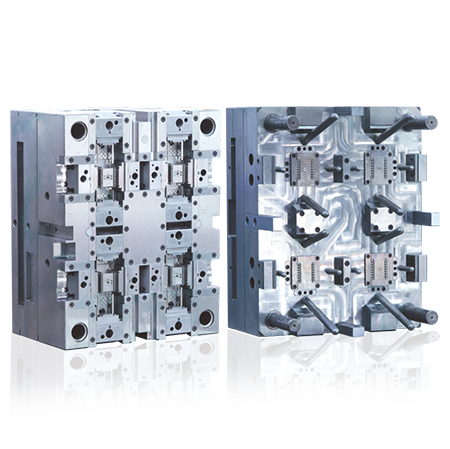Industry Dynamics
What knowledge do you not know about the cross-sectional design of injection mold runners
2023-01-14 19:04:26
The cross-sectional design of the injection mold runner, with a larger cross-sectional area, is conducive to reducing the flow resistance of the injection mold runner; A smaller cross-sectional circumference is beneficial for reducing the heat loss of molten plastics. The parameter used to measure the flow efficiency of a runner is called the specific surface area, which is the ratio of the circumference to the cross-sectional area of the runner during injection molding, that is, the ratio of the runner surface area to its volume. The smaller the specific surface area, the higher the flow efficiency. The advantages of circular cross-section: small specific surface area, less heat dissipation, and low resistance.

Disadvantage: It needs to be set up at both the front and back, and they must match each other, making manufacturing more difficult. The flow efficiency of the U-shaped section is lower than that of the regular and regular sections, but injection molding is easier to process and easier to demold than the circular and square section flow channels. Therefore, the U-shaped section flow channel has excellent comprehensive performance. Usually, the cross-sectional shape of the diversion channel for the second plate mold (excluding the second plate mold pushed out by the push plate) is preferred to be circular, while the cross-sectional shape of the transverse diversion channel for the third plate mold and the diversion channel for the second plate mold pushed out by the push plate are preferred to be U-shaped. The slope between the waist of U-shaped and trapezoidal sections is generally 5 °~10 °. The diversion channels of semi-circular and rectangular sections are not suitable for use.
1. Determine the cross-sectional dimensions
The cross-sectional design of the injection mold runner is mainly determined based on the fluidity of the plastic used, the quality of the plastic, the wall thickness of the plastic, and the length of the runner. The diameter range of various plastic diversion channels can be calculated based on equal area if trapezoidal or other shapes are used. There are usually three methods to accurately determine the diameter of the splitter. One method is to determine the quality of the root plastic part, two methods are to determine the projection area of the plastic part on the parting surface, and three methods are to determine the quality of the plastic part, wall thickness, and diameter of the diversion channel.
① PS, ABS, SAN, BS and other plastic parts have their runner diameters determined based on the weight and wall thickness of the plastic parts.
② PE, PP, PA, POM and other plastic parts have their runner diameters determined based on the weight and wall thickness of the plastic parts.
③ After identifying the cross-sectional diameter D of the diversion channel, and then determining the correction factor f based on the length L of the diversion channel, the diversion channel diameter Do=Df is calculated Regarding the cross-sectional dimensions of the trapezoidal section and U-shaped section splitters, the diameter D of the splitter can be determined first before calculation.
Note:
(1) The above three methods are all reference dimensions for polystyrene flow channels in general situations, while other plastics can be modified as necessary based on their characteristics and the shape of the plastic part.
(2) The size of the diversion channel referred to in these three methods refers to the correction factor size of the diameter of the circular cross-section diversion channel. If other cross-sections are used, they can be converted.
(3) When determining the size of the runner, it is also necessary to consider the standard value of the cutting tool during processing.
The function of auxiliary flow channels is as follows:
① Injection mold melt flow improves molding quality. The through-holes in plastic parts can hinder the filling of the melt. If the through-holes are large, it can cause forming defects such as fusion marks and insufficient filling. Plastic parts have large through-holes, and adding auxiliary flow channels in appropriate positions can greatly improve the flow of the melt and improve the quality of the plastic part.
② Injection molding molds are convenient for packaging, and multiple small plastic parts are connected in series with auxiliary flow channels. In this case, the auxiliary flow channels should pay attention to the following points. a. The cross-section of the flow channel is generally circular; b. The diameter of the flow channel is generally Φ 3mm Φ 4mm; c. The size of the gate is 2mm x 1mm, and each plastic part generally requires two or three gates to be connected; d. The auxiliary flow channel should be connected to the flow channel to facilitate the flow of the melt; e. Push rods should be added to the auxiliary flow channel; f. The adhesive position of the lettering mark on the auxiliary channel is formed by the fixed model cavity; g. Engraved characters protrude by 0.2mm.
③ The strength and rigidity of injection molded parts.
④ Injection molds facilitate subsequent processing by connecting multiple small plastic parts together with auxiliary flow channels. The plastic parts in need of chrome plating (metallization of plastic parts), and the auxiliary flow channel is not only convenient for transportation and packaging, but also convenient for chrome plating during clamping.
⑤ Add auxiliary flow channels to keep the plastic part in the back mold. For plastic parts with symmetrical parting surfaces on both sides of the injection mold, it cannot be guaranteed that the plastic part will remain in the dynamic model cavity with a ejection mechanism after opening. In this case, a U-shaped high-strength and rigid auxiliary flow channel can be opened to connect the plastic part, increasing the adhesion force of the plastic part to the dynamic model cavity.

